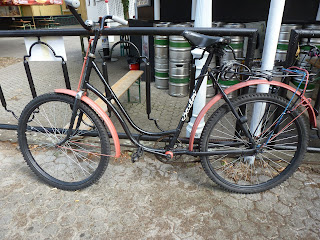For the half-century or so that I've been a dedicated cyclist, every few years, new life has been breathed into a long-discredited claim. The only difference was that back in the day, the oxygen for the myth came from word of mouth, print media and, less often, radio and television. These days, like almost every other false rumor, it's spread through the "air" of the online world, specifically social media.
What is that claim? Cycling causes male infertility. Fortunately, every time it's echoed, someone who knows way more than whoever started or resurrected the story shoots it down. To my knowledge, no study confirming a link between a man's cycling and his inability to produce progeny has been published in the New England Journal of Medicine, Lancet or any other peer-reviewed journal.
Interestingly, such a connection is not the most ludicrous one ever made with cycling. As I've mentioned in an early post, the pseudo-phenomenon of "bicycle face" was reported (in women, of course) during the "bike boom" of the 1890's. Around that time, bicycling was also blamed for a decline in marriage because "the young men go off on their wheels and leave the young ladies to themselves."
In that vein, another columnist wondered "What does Juliet care for a sofa built for two when Romeo has his tandem?" in blaming bicycles for a decline in furniture sales. If IKEA had known that, would they have sold bicycles, if only briefly?
(IKEA ceased selling the bikes because some of the belt drives--which substituted for chains--snapped, resulting in rider injuries. The company said they couldn't find a way to remedy the problem and recalled all of the bikes sold in the US.)
It seems that cycling was linked to an increase in appendicitis. The doctor who made the connection noticed only a coincidental rise in the disease and cycling. He didn't offer a cause-and-effect explanation, so I am guessing that he, with all of his training, missed something that I--who haven't taken a science class since Donna Summer did her version of MacArthur Park (as if we needed a cover of that song!)--understand: Correlation does not equal causation.
Oh, and cycling has also been implicated in--are you ready for this?--women smoking. Of course, that claim was made in England, decades before the US Surgeon General's warning on the dangers of smoking. We've all seen that famous image of 1920s Tour de France riders taking a smoke break: at the time, it was commonly believed that puffing on Gauloises or Gitanes (or Marlboros) "opened up the lungs." Also, at the time of the "cycling causes women to smoke" claim was made, in much of "polite" society, "proper" and "Christian" ladies didn't drink, show their ankles, swear--or smoke or ride bikes.
(The last dedicated cyclist whom I saw smoking was a guy I met when I was working at American Youth Hostels. Any time we were about to climb a hill, he stopped to smoke. He claimed that it made the ride up easier. And it seemed that when we stopped at a deli or cafe, he'd order its most unhealthy sandwich or dish and wash it down with the drink containing the most sugar.)
Of course, given what I've said about blaming women smoking on cycling, it's no surprise that cycling has been blamed for mental illnesses and moral decay--"the erosion of the Christian family," as an example.
Do you know of any other personal or societal maladies that have been blamed on bicycling?































.jpg)














